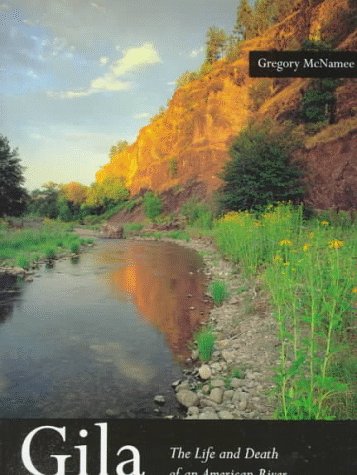In 1944, a party of German prisoners-of-war escaped from a camp in Phoenix, armed with old maps and with the intention of stealing a boat and sailing to Mexico. When they saw the “pitiful trickle” that is the modern Gila, they began to hike downstream in despair and were soon rounded up. Their leader later complained, “I only wish the Gila really had been a river. If it has no water, why do the Americans show it on their maps?” In the spirit of Edward Abbey (and with a few of his prejudices against such things as cows), Gregory McNamee goes a long way toward answering this question in his readable, but never shallow, history.
He begins in the first person, in the high 10,000-foot-plus headwaters of the river, the forests of southern New Mexico, during a vivid September thunderstorm, then casts back into geological history to when the Gila was a sea bottom, 150 million years ago. He passes rapidly, though not superficially, through paleontology and slows down as humans arrive. His treatment of early Indian history seems comprehensive and taught me much I did not know. Entering upon the history of existing tribes, he takes for a chapter epigraph a haunting quote from an Apache elder that might stand for the whole book: “The land is always stalking people.”
His coverage of the conquest is fair. If it seems at times to be critical and perhaps a little politically correct, his documented account of the watershed is hard to dispute, and depressing. He does give occasional glimpses of another side; I found it fascinating that the Church in the 1600’s had declared, “He sins against Divine Providence who tries to improve what God, for inscrutable motives, has wished to leave imperfect,” and that it therefore disagreed with Father Kino’s public works projects. There is wit here, too; McNamee, writing of the peripatetic Kino, wryly observes, “Qui multum peregrinatur, raro sanctificatur“—”Who travels much is rarely made a saint.”
But the darkness deepens, as the history of the Gila drainage comes to resemble a novel by Cormac McCarthy. McNamee rightly observes a fact still overlooked today: the Spanish invented the taking of scalps that became an industry, one indulged in by all sides in the 19th century: “By 1800 . . . a mat of scalps numbering in the thousands bedecked the great doors of the cathedral in Chihuahua City.” Blood flows plentifully through that century and into ours, but the river, strangled by dams and irrigation and the cutting of riparian vegetation, beset by overgrazing of its watershed, diminishes until the hapless German prisoners find themselves walking on sand. Phoenix is founded, grows, metastasizes, sucks up water, eventually changes the climate. (A “Phoenician . . . will use three hundred gallons of water daily, the highest rate of consumption in the nation.”)
McNamee then examines the natural history of the Gila basin. As much as I like this book, I think he is at his weakest here, using perhaps too many secondary sources. The Dust Bowl affected eastern rather than southern New Mexico. Bitterns do not live in the mountain headwaters of the Gila; the state has one of the healthiest populations of cougars on the continent (which is not to say that they should be killed indiscriminately); squirrels are not hunted for their coats; and the Puerco on the other side of the divide, not the Gila, is the muddiest river in the world. (The Gila undoubtedly comes close.) “Speciation” means something very different from “diversity.” Each of these errors is minor in itself, but the cumulative effect weakens McNamee’s authority.
On the subject of cattle, McNamee is right about the ill effects of overgrazing in the 1890’s but probably far too pessimistic about the possibility of a rapprochement between modest cattle grazing and environmental health. However, he does not stand alone in this respect; the polarization of this issue is one of the tragedies of the modern West.
I do not want to leave the impression that Gila is a seriously flawed book. Though it is possible to quibble with details, McNamee’s central thesis—that greed and shortsightedness have trashed and continue to abuse a once magnificent and still haunting landscape—is inarguable. His documentation of the unintended effects of dams and reckless water policies is (forgive me) particularly damning. “When the great rains of October 198? came, the rusty floodgates at Coolidge Dam failed to open. Glen Canyon Dam, on the Colorado, shivered loose from its bedding in soft sandstone, and its operators sounded a warning that it might collapse at any minute—taking with it, in turn. Hoover Dam, Davis Dam, Parker Dam, and Imperial Dam.” The story of the Central Arizona Project, its expense, destructiveness, and worthlessness, should be a lesson to conservationists and conservatives alike.
Finally, McNamee refuses to give in to facile pessimism. His models are Aldo Leopold and Ed Abbey, people who transcended contemporary culture’s short attention span and simplistic political divisions. In a statement reminiscent of Abbey, McNamee remarks, “To dam a river is only to pretend that risk can be minimized, and ours has been a risk-fearing age, to the great delight of insurance companies and cowards.” And in the spirit of Leopold, he concludes: “The nature of human beings is to dream. The nature of writers is to spin tales. It is time that we turn to better stories and dreams than we have now.
“A flowing Gila would be a start.”
[Gila: The Life and Death of an American River, by Gregory McNamee (New York: Crown) 215 pp., $24.00]

Leave a Reply